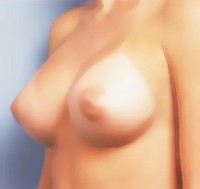 
The mammary glands, or breasts, are organs of the female reproductive system that are are designed to secrete milk following pregnancy. A mammary gland is made up of fifteen to twenty lobules, each connected to a lactiferous duct exiting at the nipple, and surrounded by fat and connective ligaments which attach to the pectoral muscle.  The breasts are actually modified sweat glands. Both males and females have glandular tissue under the nipples, but breast growth is regulated by hormones. In males, the release of testosterone at puberty stops the growth of the mammary glands; in females the estrogen released during puberty causes their breasts to develop further, with larger deposits of adipose tissue (fat). Only after giving birth are the mammary glands ready to produce milk. During pregnancy, several special hormones cause the mammary glands to continue to develop. Placental estrogen helps develop the ducts, and placental progesterone develops the gland lobules. While this can cause the breasts to enlarge, the glands do not begin to secrete milk until after the child is born. The onset of milk production is triggered by the hormone prolactin, which is produced by the pituitary gland. The initial fluid secreted by the breasts when a baby is nursing is called colostrum, and contains antibodies which help protect the baby from infections. |